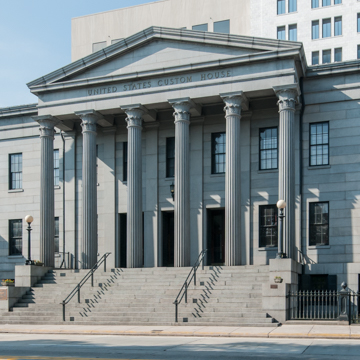The custom house is one of the most significant buildings in Savannah, set on one of its most historically notable sites. Here Oglethorpe occupied a house, and at the rear of the site John Wesley, later the cofounder of Methodism, preached his first sermon in America. The grand edifice reflects the importance of Savannah's port by the mid-nineteenth century and the growing assertion of federal power. New York architect Norris gave the building an appropriately stern character in a severe Greek Revival style virtually devoid of ornament and clad the exterior with gray granite from Quincy, Massachusetts. A steep staircase leads to the imposing and remarkable portico of six monolithic columns, true feats of engineering that accurately follow the unusual form of the baseless Corinthian order used at the Tower of the Winds in ancient Athens. The historic marker's reference to tobacco leaves in the captials is erroneous. Still-functional iron shutters and heavy iron doors provided palpable security and—along with the accordion-pleated, self-spanning wrought-iron roof (one of the earliest in the county)—protection against fire. Inside, the lobby leads to an impressive grand stair with paired curving cantilevered flights above the landing and a half dome above. In the basement an impressive column supports the thick granite floor slabs of the lobby above. Originally also housing a U.S. post office and federal courthouse, this remains the oldest functioning federal building in the state of Georgia, and still serves as the city's custom house.
You are here
United States Custom House
If SAH Archipedia has been useful to you, please consider supporting it.
SAH Archipedia tells the story of the United States through its buildings, landscapes, and cities. This freely available resource empowers the public with authoritative knowledge that deepens their understanding and appreciation of the built environment. But the Society of Architectural Historians, which created SAH Archipedia with University of Virginia Press, needs your support to maintain the high-caliber research, writing, photography, cartography, editing, design, and programming that make SAH Archipedia a trusted online resource available to all who value the history of place, heritage tourism, and learning.














